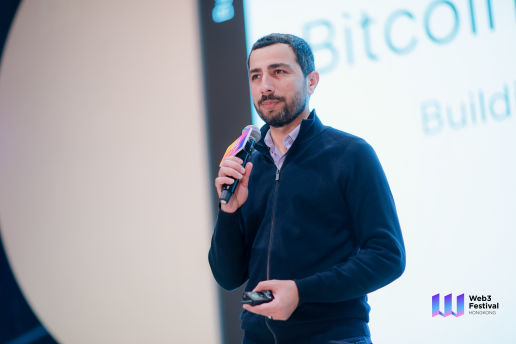Our mission at Trust Machines is to build the Bitcoin economy.
Since our inception, we have made it clear that tapping into the Bitcoin blockchain network can unlock a whole new world of possibilities, redefining how we engage with existing financial and societal institutions. The possibilities that can exist with the Bitcoin network are endless, and we're dedicated to bringing everyone into a world where they can enjoy all the opportunities that come with blockchain technology with Bitcoin as the base application layer.
Last week, our co-founder and CEO, Muneeb Ali, delivered a keynote at the Hong Kong Web3 Festival that argued for scaling solutions to enable the establishment of flywheel economies with Bitcoin as the base layer.
There, he delved into why layer 2 solutions are necessary to unlock Bitcoin's layer 1, and why that is crucial for the crypto industry's future. He also painted a picture of why Bitcoin's future is brighter than ever thanks to a milestone development for the layer one blockchain: Ordinals.
Why Build on the Bitcoin Blockchain?
Bitcoin is the oldest blockchain protocol, and has been known to provide a high level of decentralization and security. The blockchain prioritizes security and stability through its design and unique Proof-of-Work (PoW) consensus mechanism.
The result? To this day, Bitcoin is still the most popular layer 1 blockchain in the world.
Newer blockchain platforms like Ethereum and Solana still haven't been able to catch up to Bitcoin. And while comparisons between, say, Bitcoin and Ethereum point out that the Ethereum blockchain provides more smart contract capabilities than Bitcoin does, the Bitcoin layer 1 network has still managed to capture the world's attention.
Ali emphasized that Bitcoin has, over time, actually become a $500 billion asset class, though the bulk of that value remains undiscovered. Much of that value comes from the stability that the underlying blockchain provides, and the number of blockchain users that have flocked to Bitcoin as a result.
"The value Bitcoin provides is durability," he said. "If there is one chain that will survive 20 to 30 years from now, the highest probability [lies with Bitcoin]."
The Current State of Bitcoin: The Importance of Bitcoin Blockchain Layers

Trust Machines CEO Muneeb Ali speaks at the Hong Kong Web3 Festival on April 14, 2023
Unfortunately, Bitcoin remains a relatively passive asset, according to Ali. As we mentioned, much of Bitcoin's value is still locked, and that's because the blockchain architecture faces the a classic issue among all layer 1 blockchains: the Blockchain Trilemma.
In this case, the Bitcoin blockchain was built to prioritize blockchain security by design, which affected its blockchain scalability. In order to solve the Blockchain Trilemma as it relates to Bitcoin, various scaling solutions were developed for the Bitcoin ecosystem.
This is where layer 2 blockchain solutions come in. From the Lightning Network (which speeds up and facilitates Bitcoin transactions) to the Stacks Bitcoin protocol (just two examples of layers), layer 2 scaling solutions have emerged to allow developers to build on top of the main Bitcoin network layer. Thanks to these Bitcoin layer 2 protocols, decentralized applications have been able to expand on top of the base layer leading to the creation of DeFi projects, NFTs, DAOs, and more. In other words, layer two protocols have been at the heart of some of the most innovative projects build on top of the layer 1 BTC chain.
But while Bitcoin still retains its place as the biggest blockchain system and layer 2 networks have helped to ensure that, even layer 2 Bitcoin solutions remain underutilized. In fact, the entire Bitcoin L2 market cap is below $2 billion, meaning that even Bitcoin's common layer 2 scalability solutions match the layer one network in untapped potential.
However, Ali described a "huge opportunity to come" for Bitcoin and its layer two blockchain scaling solutions thanks to a new protocol that emerged on layer 1 Bitcoin: Ordinals.
Bitcoin Ordinals' Impact on Bitcoin Layer 1
The Ordinals protocol, as we know, has dominated discussions within and outside of the Bitcoin ecosystem for months. The practice of ascribing content to individual satoshis directly on the Bitcoin blockchain has shifted perceptions of Bitcoin as an implementation layer and its underlying blockchain architecture.
And as a result, more builders are flocking to Bitcoin. Many are even returning from other blockchain networks to participate in one of the most pivotal developments in Bitcoin's history.
"This cultural change in Bitcoin should not be taken lightly," said Ali. "New explorers, new infrastructure, wallets, etc. are coming online now. As a result, I think we will start seeing the use cases on the Bitcoin economy expand."
Just last week, the Bitcoin blockchain surpassed 1 million Ordinal inscriptions less than three months after the protocol's launch. Despite the short time frame, there are already many people in the Bitcoin ecosystem who believe in the protocol's enduring popularity.
But most importantly, the cultural shift and momentum Ordinals have brought to the Bitcoin community only confirms what we, at Trust Machines, are building towards: a future where Bitcoin serves as an effective settlement layer for applications that will change the world.
As Ali told the audience in Hong Kong, thanks to Ordinals, "the Bitcoin thesis is now coming true."


